ТОП просматриваемых книг сайта:
The Sword of the People. Roberto Laura
Читать онлайн.Название The Sword of the People
Год выпуска 0
isbn 9783347056480
Автор произведения Roberto Laura
Жанр Учебная литература
Издательство Readbox publishing GmbH
The Sword of the People
History, Culture, and Methodology of the Traditional Italian Knife Fight
by Roberto Laura
© 2020 Roberto Laura (English edition)
Cover design and illustrations: Roberto Laura and Irina Hutzler
Text: Roberto Laura
Editing: Roberto Laura
Translation and proofreading for the English edition: Aurelia Sedlmair, Dr. John Crescione, DC, and Joaquin “Jack” Montes
Publisher: tredition GmbH, Halenreie 40-44, 22359 Hamburg
ISBN: 978-3-7323-2866-6 (hardcover); ISBN: 978-3-347-05648-0 (e-Book)
The entire work is protected by copyright. Any use is prohibited without the consent of the publisher and the author. This applies in particular to electronic or other duplication, translation, distribution and public disclosure. Bibliographic information of the German National Library: The German National Library lists this publication in the German National Bibliography. Detailed data are available on the Internet at http://dnb.d-nb.de.
“For My Son Giuliano, My Wife Simone, and My Parents Alda Rosso and Bruno Laura”
Table of Contents
Introduction
Chapter 1
A Quick Look at the History of Fencing in Italy
Foreword
1.1 Introduction
1.2 Gladiators
1.2.1 Regional Development
1.2.2 Commonalities
1.3 The Newly Kindled Spirit
1.3.1 Art and Literature
1.3.2 The City-States
1.4 With Sword and Dagger
1.4.1 Fiore dei Liberi
1.5 The Rapier and the Fencing School
1.5.1 Achille Marozzo
1.5.2 Camillo Agrippa
1.5.3 Nicoletto Giganti
1.5.4 Salvator Fabris
1.5.5 Ridolfo Capo Ferro
1.5.6 Ferdinando Alfieri
1.5.7 A Summary of the Technical Developments in Fencing, in so far as they Concern Popular Knife Fighting
1.6 The Possible Transitions from the Sword to the Knife
1.6.1 The Prohibition to Carry Weapons or Duel, and the Consequent Development of Knife Fighting
1.6.2 The Culture of the Common Folk
1.7 The Dagger and the Italian Military, the Arditi
1.8 Recapitulation
Chapter 2
The Weapons Schools of Southern Italy; a Historical and Cultural Overview
2.1 Introduction
2.2 First Cultural Influences in the Area, Legends, and First Evidence of Duels
2.2.1 The Knightly Puppet Theater
2.2.2 The Three Spanish Knights
2.2.3 The Song of the Mafia
2.2.4 Oppressed in their own Country
2.2.5 The Duel – First Evidence and Prohibitions
2.3 Possible Further Influences on the Fencing Schools of the South
2.3.1 Spain
2.3.2 Brigands
2.3.3 Criminal Syndicates:
2.3.3.1 The Camorra
2.3.3.2 The `Ndrangheta
2.3.3.3 The Mafia / Cosa Nostra
2.3.3.4 The Stidda
2.3.3.5 Sacra Corona Unita
2.3.4 The Gambling Games of the Society and Tattoos
2.4 Uomini di vita, uomini di malavita, and the bulli
2.5 The Influence of Catholicism on the Fencing Schools of Southern Italy
2.6 The tarantella, the pizzica-pizzica, and the imbrecciata
2.7 Recapitulation
Chapter 3
The Rules of the School, the Language, and the Society
3.1 Introduction
3.2 An Important Note
3.3 Pythagorean Influences
3.4 Jargon
3.4.1 Campania / Naples
3.4.2 Northern Apulia
3.4.3 Calabria
3.4.4 Sicily
3.5 Hierarchy and Graduations / Titles within the Schools or Clans
3.6 Dogmas
3.6.1 Overview
3.6.2 San Michele Archangelo, Saint Michael the Archangel
3.7 The Rules of Favella or even the Codici Sociali
3.7.1 Codice Sociale dei Aspromonte – the Social Rules of Calabria
3.7.2 Other Rules and Poetry; the Old Rules of Naples
3.8 Correspondence and Non-Verbal Communication
3.9 An “Actual” Case
3.10 Recapitulation
Chapter 4
The Two Paths: Dueling With and Without Conventions
First, a Personal Remark
4.1 Impressions of a Duel
4.2 A Definition
4.2.1 Appicceco
4.2.2 Raggiunamento
4.2.3 Questione
4.3 Examples of Classic Confrontations with the Knife
4.4 The One Great Commonality
4.5 Cultural, Technical, and Tactical Peculiarities – Schools of the Hall
4.6 Cultural, Technical, and Tactical Peculiarities – Systems of Defense
4.7 Recapitulation
Chapter 5
Schools of the Hall or Duel: Regional Developments in Apulia
5.1 Introduction
5.2 According to the Rules of the School: the Secret Knife Schools in Apulia
5.2.1 Regional Allocation
5.3 The Knife Tradition from Manfredonia, or the School of the Knights of Humility
5.3.1 Overview
5.3.2 La Scuola, the School
5.3.2.1 Curriculum
5.3.2.2 Gymnastics
5.3.2.3 Didactics – the Way of the Forms
5.3.2.4 Didactics – the Way of the Figures
5.3.2.5 Didactics – the Way of the Thrusts
5.3.2.6

